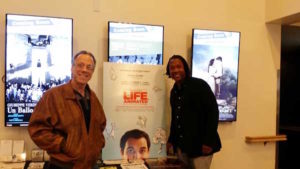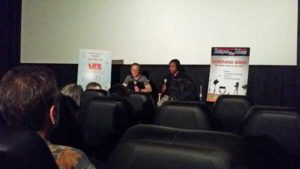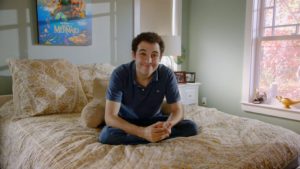
Life, Animated is a coming-of-age story enriched by the fact that the main protagonist, Owen Suskind, is both a real person and a young man with autism who is just starting to become self-sufficient and have his first experience with falling in love.
The original idea for the documentary was to be based on a book by Owen’s father, Ron Suskind titled Life, Animated, A Story of Sidekicks, Heroes and Autism. The book is a 20-year history of Owen’s life which starts with him as an active, normal 3 year-old who suddenly went silent and who, for years, was unable to communicate with his family or others. Eventually, the family discovered in an amazing way that Owen was learning to interpret and understand life around and inside him through the Disney animated films that he watched over and over.
As producer/director Roger Ross Williams started filming, he realized that he had a wonderful opportunity to expand on the book by participating in the coming-of-age story that was unfolding in front of him rather than focusing on the past and following the book. Williams said that he didn’t know much about autism when he started this project.
“I was uncomfortable with him (Owen) and realized that I wanted the audience to take that same journey that I did and to get inside his head and empathize,” said Williams.

The film is a deeply moving one that shows both visually and audibly how Owen almost taught his family to understand him.
Williams said, “The way Owen interprets and processes stories is fascinating to me, and it opened me up as a filmmaker in terms of the different narrative devices I could use to tell his story. I came to love the way Owen processes media. He’s looked into a television screen for his entire life and he knows the words to every Disney animated film ever made. He not only knows them intimately, he uses them to decipher the way in which the world works and, most importantly – how everyone is important to the way things go.”
The process of making the film took about 2 years. The director of photography on the film was Tom Bergmann who has more than 30 shorts and features to his credit. His filming of Owen was made easier by the fact that once he got used to Bergmann and Williams being around, Owen was completely oblivious to the camera.
In terms of working with Disney on the rights for the animation clips, Williams said that it was very important to develop a relationship with them from the very beginning. He said that he and producer Julie Goldman met with the top executives from all the departments that they needed to work with and he nervously showed them the storyline. Ron Suskind refers to that day as “The day he made the lawyers cry!” With Disney on board, they were able to license all the footage in the film.

David Teague is a documentary film editor who has served as an editing mentor with the IFP Documentary Labs and the Karen Schmeer Film Editing Fellowship and is the author of two best-selling guides to film editing with Final Cut Pro. He faced quite a challenge in editing the film, in fact, it took about a year to do so. The film blends the Disney animation with line drawings and scenes created by Owen, with vérité footage and home movies.
Said Williams, “Owen created the scenes. At a young age, he started drawing his beloved sidekicks — and he never drew heroes, only sidekicks. He made a story out of this called The Land of the Lost Sidekicks, and it’s a world that is quite beautiful. I worked with Owen and an amazing team of animators in France at Mac Guff Animation to bring to life Owen’s elaborate fantasy world. The villain Owen created for his story seemed to correspond with the challenges that he faces in his own life; it came to symbolize his autism in that the creature’s power was to make a person’s mind fuzzy or confused. While Owen was creating this story, he was in some ways writing his own biography or narrative, so I very much wanted to animate that on screen.”
Williams said that the sound was also an important part of the film. “In the film you see various Disney clips playing on a screen, and Owen mouths every line. Visually, the issue was about getting inside Owen’s head and bringing that to life in the film. Sound wise, we captured Owen channeling all the different characters with their widely divergent voices and turned this into its own musical language. Dylan Stark and Todd Griffin, our composers, recorded Owen’s self-talking in addition to sound effects like the sound of VHS tape fast forwarding, etc. And then the brilliant Pete Horner and Al Nelson at Skywalker Sound turned it into a mix. So the film is very much a sonic journey as much as a visual one.”
This film gives an honest and open look into the life of one extraordinary young man and his family. It touches the heart, brings tears to the eyes and laughter to the lips and an amazing sense of the wonder of the human brain and spirit that can create such wisdom from what we call “illness”.
Williams shared, “In Owen’s understanding of story, everyone matters, everyone is indispensable to what transpires and everyone has a right to claim the jointly held story as their own. That is the beauty of story that I learned from Owen Suskind.”





